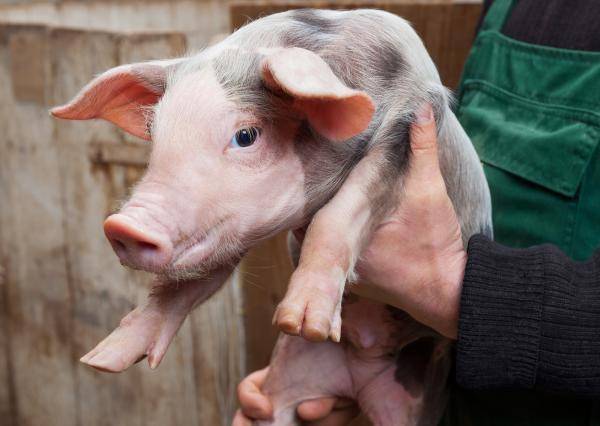In the animal feed world, "copper time" with increased levels of copper in pig feed seems to be definitively on the decline. After banning pharmaceutically high zinc levels in piglet feed, a new European law (EU 2018/1039) dictates a step-by-step reduction of the maximum permitted copper levels, gradually revealing the contours of a new era. For example, pig feed may now contain a maximum of 150 ppm of copper–regardless of weaning age–for up to 4 weeks after weaning, but in the next phase up to 8 weeks after weaning, that content must be further reduced to a maximum of 100 ppm. The question remains which form of copper is the most appropriate in the new piglet feeds that will arrive on the market from 13/8/2019 at the latest. DSM has looked into this for you.
Although acute copper deficiency in pigs rarely or never occurs, this trace element is also necessary for optimal health of newly weaned piglets. It is known from literature and practice that elevated copper levels have a positive effect on piglet performance. Based on recent research by Bikker et al. (2015), it is estimated that when the new copper legislation is applied, the expected body weight will be approximately 0.8 kg lower 8 weeks after weaning. The reduced copper addition will therefore not go unnoticed by pig farmers. Just as in the days of hunters and gatherers the copper objects were replaced by bronze and iron, replacement measures will also need to be taken now.
Alternative copper sources
In 2019, compound feed nutritionists are diligently searching for compensating strategies. The use of alternative copper sources is a route that is receiving much attention. They can be subdivided into inorganic and organic sources. The latter group is characterised by a combination of copper and organic matter (protein or amino acid) and generally has a lower copper content.
Due to the favourable copper connection, a higher bioavailability is attributed to these sources compared to inorganic copper sulphate. In addition to the antibacterial effect (intestinal health) of increased copper levels, the stimulation of feed uptake (systemic effect) is also mentioned. In the latter case, it is precisely the organic sources that would offer additional benefits. On the other hand, the antibacterial effect is maintained because the increased absorption is compensated by the secretion of copper in the intestine via the bile salts. Organic sources appear superior to inorganic sources in this way, although the latter are generally cheaper. Suppliers of inorganic sources mainly bet on higher copper activity in the gut due to lower bioavailability.
The new legislation and the different views on copper sources prompted Twilmij / DSM to undertake a literature study and set up a comparison trial with newly weaned piglets: what do the piglets themselves think about it?
.jpg)
Literature research
A preliminary literature study examined the various effects of a variety of copper sources on weaned piglets. For each parameter, the percentage improvement compared with the reference feed (= with copper from copper sulphate) was mapped. The parameters examined are growth, feed uptake, feed conversion, liver and blood values and bioavailability. Only the studies with equal copper levels between the treatments and the control were examined. Studies with feeds without phytase or with pharmaceutical levels of zinc were not included in this study.
A weighting factor was added to the examined parameters and a score was calculated for the various copper sources relative to copper sulphate. The comparative study, which also includes the number of piglets, shows that copper sulphate generally scores less well than other commercially available forms of copper. Organic sources show the most significant improvement here.
Piglet trial
But do the piglets feel the same way under practical conditions? Because recent literature does not include trials with a large number of different copper sources, a practical trial was also set up in the wake of this literature review.
The experiment was conducted in April-June 2019 on a commercial sow farm in Kootwijkerbroek (province of Gelderland, the Netherlands). A total of 864 piglets were selected for the trial, which came from 3 groups of weaned piglets and were started one week after the other each time. These piglets were weaned at approximately 4 weeks of age (6.3 kg body weight (BW)) and were divided into 6 sections with 12 animals per cage and 1 feed trough per 2 cages.
The piglets received 2 types of feed with 140 ppm added copper during the first 4 weeks after weaning and then another feed with 90 ppm added copper until delivery (6 weeks after weaning). The control feed contained copper sulfate (also supplied in the farrowing pen) and the five other treatments contained commercially available copper compounds (2 inorganic and 3 organic copper sources). The copper sulphate was replaced for 100% by a different source each time. The piglets, weighed at the start of the fattening stage, were equally distributed over the six treatments on the basis of weight and litter of origin. The animals were individually weighed at 4 weeks after weaning and at the end of the trial period. The feed uptake was measured per two pens.
Blood and manure samples were also taken from the various groups to determine copper concentrations in the blood and copper retention in the animal, respectively. A daily diarrhoea and piglet score was also performed. All results were statistically processed using SPSS.
Results
Table 1 shows the results of the comparative trial. The feeds with inorganic sources resulted in a numerically higher final weight on day 28, as well as at the end of the trial. This effect was also visible in the improved growth and sharper feed conversion. In terms of performance, we also examined the effect on light and heavy piglets (5.6 and 6.9 kg BW respectively at weaning). Contrary to the overall results, the control feed with copper sulphate resulted in the highest final weight for the heaviest piglets.
The piglets that were fed with an organic copper source showed a higher retention coefficient compared with the inorganic sources. There were no clear differences between treatments at blood level. Liver homeostasis and storage may play a role in this. It is clear, however, that an organic copper source results in a higher retention of copper in the animal, which may in some circumstances offer additional certainty (read: improved copper status, avoidance of shortages).
Copper sulfate treatment showed the least satisfactory manure score. The pressure on gut health, visible in a less satisfactory diarrhoea score until day 10 after weaning, may have been the reason that the inorganic sources were more prevalent. The systemic effect of copper may have faded into the background in the trial due to these circumstances, reinforced by the fact that feed uptake is sufficiently stimulated by the use of various additives (lactose, sweeteners, etc.). The open question for further research is whether such effects are also visible at lower copper levels (<25ppm).
Table 1. The effect of different copper sources on technical results, blood concentration and retention coefficient in newly weaned piglets.
.png)
Conclusions
In comparison with copper sulphate, none of the copper sources investigated showed a significantly higher feed uptake and growth. Based on this research, it can, therefore, be concluded that under these specific circumstances and based on the copper levels applied, alternative copper sources offer no immediate added value during the weaning phase, given the animal performance and the economic analysis.
This conclusion can also be translated into advice for farms with similar circumstances. Using the correct copper source cannot, however, be viewed separately from other feed measures, such as raw material and additive selection summarised in the Ultimo 2.0 and the Healthy Growth 2.0 piglet feed program from Twilmij / DSM.
For further questions and details of this research, please contact your contact in Stroe or in Deinze.
ir. E. van Lagen


